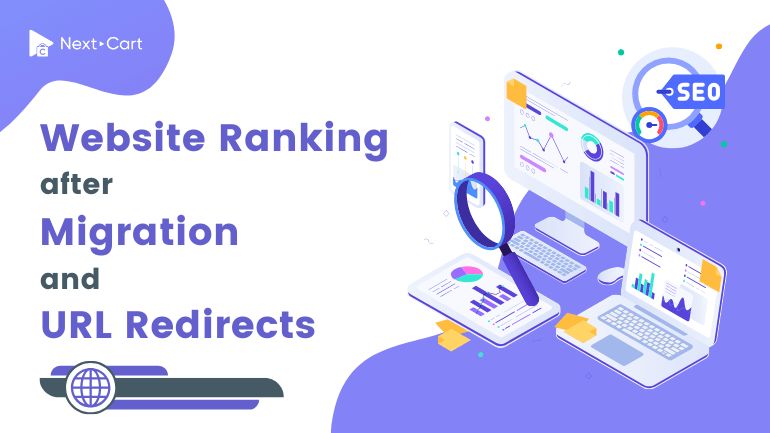
Website migration can be a complex process, especially when it involves changing URLs. One of the biggest concerns for website owners is how the migration will impact search engine rankings. When URLs change, search engines need to re-crawl and re-index the site, which can lead to temporary ranking fluctuations. However, with a well-planned strategy, you can minimize ranking losses and even improve your SEO performance in the long run. This guide will explore how changing URLs and implementing proper redirects affect your rankings, as well as best practices to ensure a smooth transition.
The Impact of Changing URLs and Setting Up Redirects
Temporary Drop in Rankings
- Initial Drop in Rankings: When URLs change during a website migration, search engines need to re-crawl and re-index the new structure. This process takes time, and as a result, rankings may drop temporarily. Google and other search engines must determine how the new URLs relate to the old ones and whether they should pass the same authority.
- Re-Evaluation by Search Engines: Search engines analyze multiple factors, including the relevance of the new URLs, the accuracy of redirects, and user behavior on the updated site. This can cause fluctuations in rankings before stabilization.
- Recovery Timeline: The time required for rankings to recover varies depending on factors like the size of the site, the effectiveness of the redirects, and the frequency of search engine crawls. In most cases, recovery takes anywhere from a few weeks to several months. Ensuring a smooth migration process can help speed up this recovery period.
Maintaining SEO Value
- Implementing 301 Redirects: A 301 redirect signals to search engines that a page has permanently moved to a new URL. This helps preserve SEO value by transferring link equity (ranking power) from the old page to the new one. Without proper redirects, search engines may treat the new URLs as entirely separate pages, resulting in ranking losses.
- Ensuring Content Consistency: The content on the new URLs should match or closely resemble the content from the original pages. Significant changes in content may lead search engines to view them as different pages, which could result in loss of ranking.
- Updating Internal Links: Internal linking is crucial for maintaining SEO value. Ensure that all internal links point to the new URLs instead of relying on redirects, as this improves crawl efficiency and user experience.
- Preserving Metadata and Structured Data: Maintain page titles, meta descriptions, alt tags, and structured data across the new URLs. These elements play a role in search rankings and should remain unchanged if possible to maintain SEO stability.
Monitoring and Adjusting
- Google Search Console Monitoring: After migration, track how Google indexes the new URLs using Google Search Console. Pay attention to crawl errors, indexing issues, and traffic changes to identify and resolve problems quickly.
- Checking Redirect Effectiveness: Regularly test 301 redirects to ensure they function correctly and do not lead to broken pages or redirect loops.
- Fixing Crawl Errors and Broken Links: Audit the site using tools like Google Search Console, Screaming Frog, or Ahrefs to detect broken links or redirect errors that could negatively impact rankings.
- Analyzing Traffic and Engagement Metrics: Use Google Analytics and other tools to monitor organic traffic, bounce rates, and user behavior. Any sudden drop in traffic or engagement could indicate unresolved migration issues that need addressing.
Benefits of a Well-Managed Transition
While URL changes and migrations can temporarily impact rankings, a well-planned process can lead to long-term SEO and user experience improvements.
Improved Site Structure
- SEO-Friendly URL Optimization: Migration provides an opportunity to improve URLs for better readability, keyword relevance, and structure. For example, replacing complex URLs with descriptive, keyword-rich ones can enhance SEO.
- Enhanced User Navigation: Well-structured URLs contribute to a better user experience, making it easier for visitors to find relevant content quickly. Intuitive navigation improves dwell time and reduces bounce rates.
- Better Crawlability: A logical site structure with a clear URL hierarchy allows search engines to crawl and index content more efficiently, leading to improved rankings.
Enhanced Performance
- Faster Load Times: Migrating to an optimized platform or server can improve page speed, which is a ranking factor. Faster load times enhance user experience and reduce bounce rates.
- Mobile-Friendly Design: If the migration involves moving to a more responsive or mobile-friendly layout, it can positively impact rankings. Google prioritizes mobile usability in search results.
- Improved Core Web Vitals Scores: A well-optimized website migration can improve Core Web Vitals metrics such as Largest Contentful Paint (LCP), First Input Delay (FID), and Cumulative Layout Shift (CLS), which are crucial for ranking.
Potential Ranking Boost
- Implementation of SEO Best Practices: A migration presents an opportunity to refine on-page SEO, including better header tag usage, image alt text, and improved keyword targeting.
- Reduction in Duplicate Content: If the old site had duplicate content issues, a migration can be used to clean up and consolidate content, improving search engine rankings.
- Improved Content Strategy: Migration offers a chance to revisit content strategy by updating outdated pages, optimizing for new keywords, and improving content quality, which can lead to better organic visibility.
Conclusion
Website migrations and URL changes come with inherent risks, but with careful planning and execution, they can lead to improved site performance, better user experience, and long-term SEO gains. By implementing 301 redirects correctly, maintaining content consistency, and actively monitoring the transition process, you can minimize ranking drops and ensure a smooth recovery.
For further reading on the supported data entities and best practices for a smooth migration, you can refer to: